Looking for a way to expand your ecommerce business or start something new? If you don’t currently have an ecommerce store, or if you have one but want to multiply the ways online shoppers can find you, selling your products on eBay might be a good option to consider.
In this article, we’ll walk you through how to start an eBay store and what you need to know to get up and running.
An introduction to eBay’s marketplace
↑ Back to topNot everyone realizes how much eBay has changed from its beginnings — becoming famous for its online auction experience. But today, about 80% of products sold on eBay are new, and only 12% of products sell via bidding.
That means that the vast majority of products sold on eBay are new, online products that people are looking for. It has become one of the top online marketplaces for ecommerce and other types of merchandise.
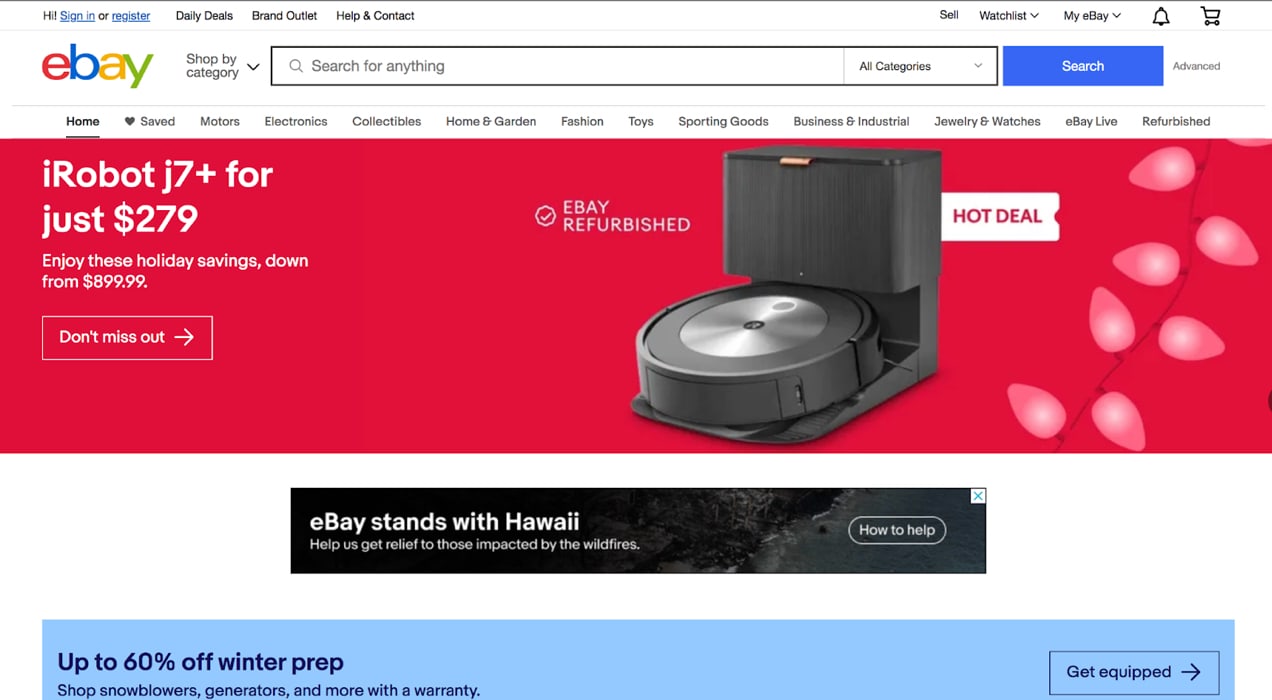
Its top-selling product categories are electronics, clothing, automotive, health and beauty, and sports and outdoors. But those top five categories make up just under 60% of products sold on eBay, which means many other product categories do very well on eBay, too.
eBay’s audience skews male, at about 60%, and over 60% of its audience is in the 35-64 age range. So, a mix of baby boomers and Gen Xers.
If that sounds like something you can make work for your ecommerce business — whether new or just getting started — read on and learn how to start an eBay store.
Setting up your eBay seller account
↑ Back to topThere are a couple ways to set up an account and sell on eBay, but the simplest one is to just click on the ‘List an item’ button at the top of most pages.
Once you do that, eBay walks you through the process of creating and verifying your account.
Choose product categories
First, they’ll ask you to select a product category for the item you want to sell. If you don’t yet have products ready to sell, it would be better to wait to set up your eBay account until your products are available.
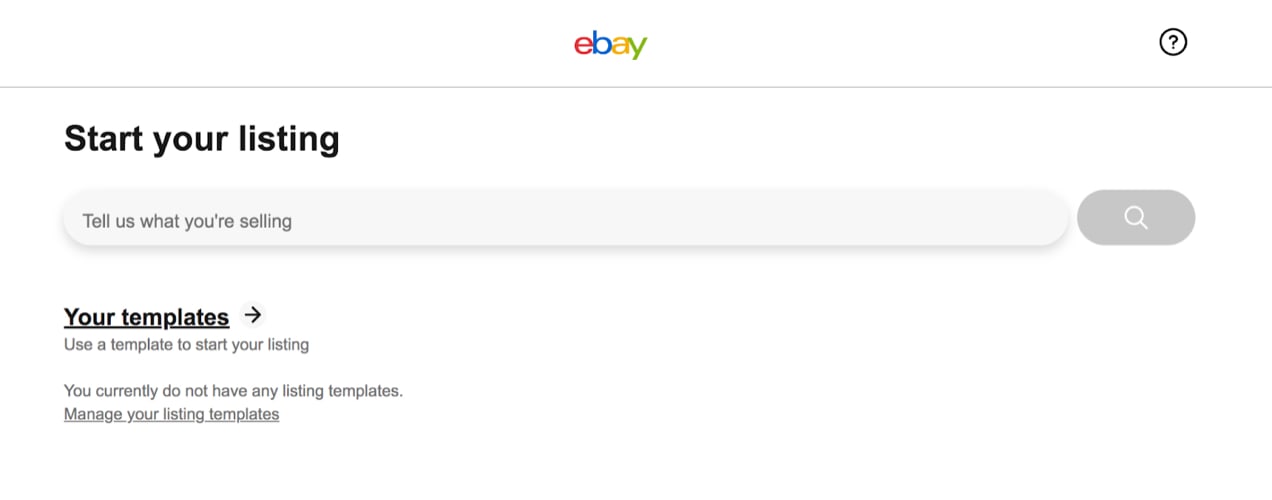
Next, you get to choose if the item is new, used, seller refurbished, “open box”, or “for parts or not working”. Most ecommerce businesses will likely be choosing “new”.
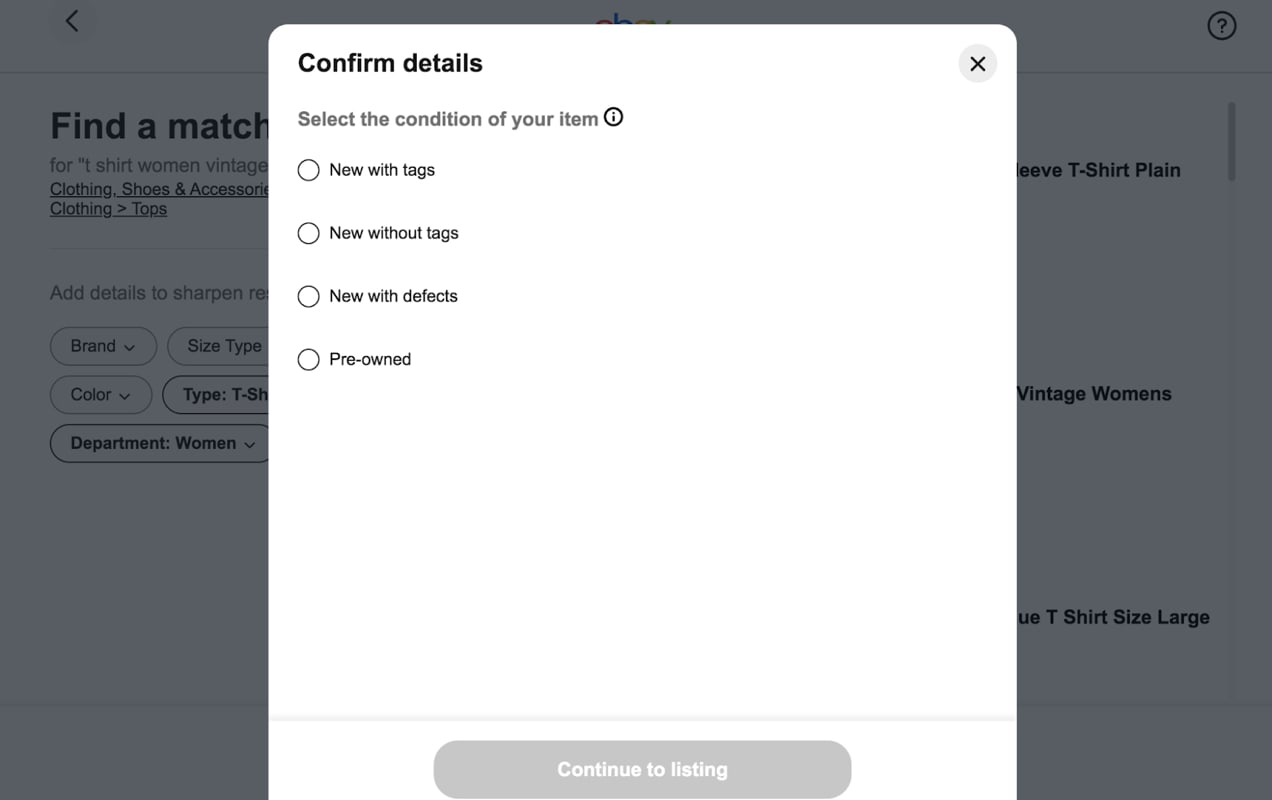
Create your account
After that, you’ll create your username and password. On this page, you also get to choose either a personal account or a business account. If you’re running an ecommerce business, intending to sell products on eBay as a consistent source of revenue, you will want to choose a business account.
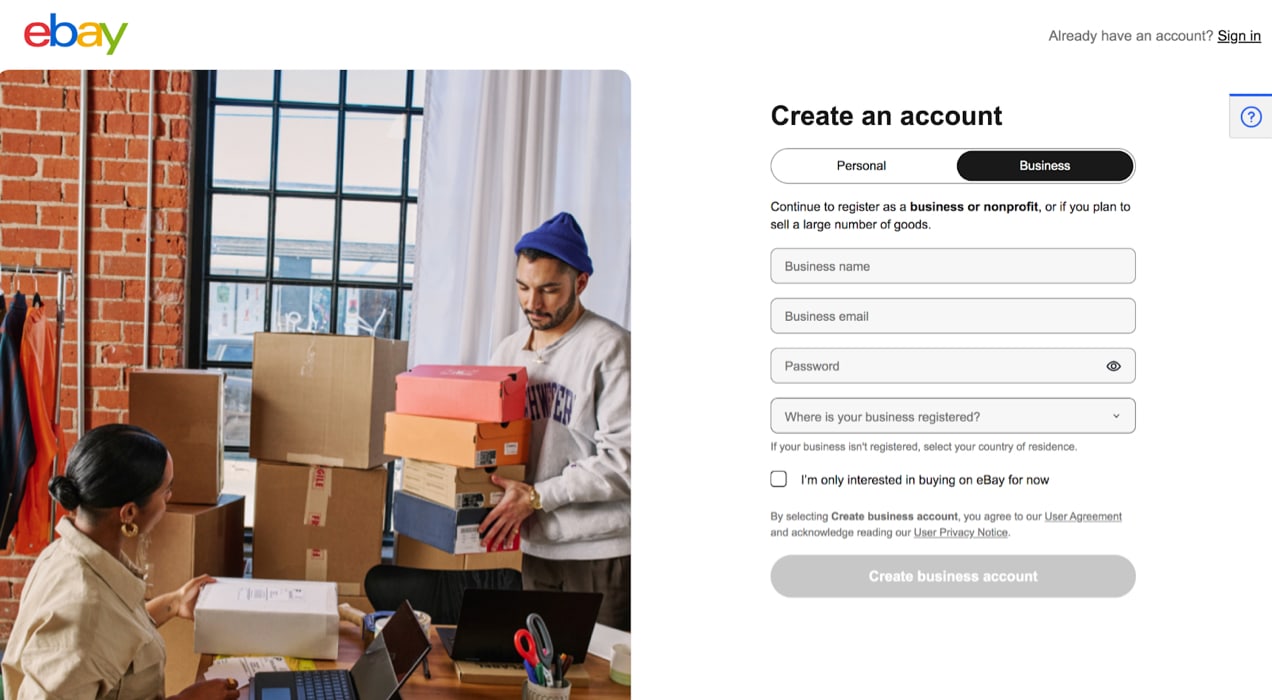
Set up payment information
Once your account is created, you can link your payment information to your account. You’ll need this to pay fees, and also to receive payment as your items begin to sell.
Before you begin this process, make sure you have all the things necessary for starting a new business — a bank account, tax information, and government-issued identification, and the like. Again, if you’re using eBay as part of your business, you need all this information to create a business account.
Set your business account preferences
Lastly, you can choose your preferences for things like shipping, return policies, and payment policies. And you can also begin familiarizing yourself with the tools and options for onboarding and inventory management.
Creating effective product listings
↑ Back to topSelling products on eBay begins with optimized product listings. You must name and describe your products using language that aligns with how shoppers search on eBay.
“eBay product listings should be meticulously crafted with compelling titles, detailed descriptions, and high-quality images. eBay’s search algorithm, known as Cassini, puts a premium on these factors, so optimizing them can significantly boost your visibility. Use eBay’s Item Specifics feature to include additional product attributes like brand, size, and color, as these can enhance search result rankings and make your products more discoverable.”
Bryan Falla, Director of Marketing at GoDataFeed
And, once they find your products, you need to use language that assures them buying from you will lead to a good shopping experience. Here’s what you need to do:
Optimize your title
You only get 80 characters for your title, so you need to focus on terms that shoppers will type into eBay to find what they’re looking for. That means, among other things:
- Give the brand name and category of the product
- Include the model, size, color, and other details people might be looking for
- Avoid punctuation and all CAPS
- Avoid adjectives and synonyms
- Don’t include contact information
Again, this is your product’s title. No one searches for “great amazing cutting-edge toenail clippers.” They just search for toenail clippers. For some products, especially accessories that only go with certain models of products, they’ll search for model numbers. So when it’s appropriate, you do want to include GTINs in your title, too.
Add quality product images
Take high-quality images from multiple angles of your products. You can upload up to 12 photos for each product listing, so there’s no reason to skimp here. Make sure the lighting is good.
If you use the eBay app, you can also clean up the images and add white backgrounds. If you are selling used or refurbished products, don’t erase blemishes or flaws, because that can lead to bad reviews if the actual product isn’t as good as the picture made it seem.
To improve your eBay SEO, you can also add alt text to each image. This is text that describes the image. While adding keywords can improve the visibility of your listing, it’s important that your alt text helps someone visualize what’s in the picture. After all, alt text was created so visually-impaired users could understand the photos included.
Include product descriptions and item specifics
You may have managed to find the absolute best products to sell online, but you still need to market them effectively. The product description is the place to make your items stand out from competitors.
Focus your description on benefits, not just features. How does this product help? What problems does it solve? What outcomes does it produce that are desirable to the buyers? Do not just describe the physical characteristics.
That’s what the item specifics are for. In the item specifics section, you want to list the specs, model numbers, compatibility details, colors, sizes, and other details that a buyer needs to know to be sure they’re getting the item they want.
Put another way, the product description sells the product, and the item specifics confirm this is the right product.
In your product description, you can also mention return policies and shipping offers, and any packaging details that might be relevant. Include any relevant testimonials as well.
Choose “Buy Now”, not auction bidding
For each eBay listing, you can choose to sell it as a ‘Buy Now’ item, or as an auction item that shoppers can bid on. For ecommerce businesses, the ‘Buy Now’ option is the way to go.
Buyers of new items don’t want to bid. It’s too stressful and adds many days to the process. They want to buy it now. So, let them. The auction style listings option is better for people selling used or specialty items.
How much should you charge?
↑ Back to topYou can look at competitor pages to see what they’re charging. While you’re there, take note of how they describe products similar to yours. What can you do better in your descriptions?
You can consider offering discounts, coupon codes, volume pricing, or discounted shipping options — this too would go in your product description.
eBay also allows you to create a customer email list. You can promote this on your eBay store and product pages, and use it to incentivize future purchases, as well as to offer discounts on their first-time purchase with you. Then, you can use your email list to market to the same customers repeatedly. This is something you cannot do when you sell on Amazon or other marketplaces.
Lastly, you have the option of advertising your products on eBay’s platform using eBay Ads. You’ll get far greater visibility. This is something to consider trying out as your eBay store grows its revenue.
Understanding eBay’s fees and pricing structures
↑ Back to topAt its core, eBay’s fee system is pretty simple. They charge a listing fee, and a sellers fee, and that’s it for the most part.
Listing fee
The listing fee is 35 cents per listing, and your first 250 listings are free. If you set up a business account — which you should if you’re planning to use eBay as part of your ecommerce business — you can get even more free listings depending on the plan you choose.
The listing fee is good for as long as the item is on your store. But each month you have to relist your items, and you pay each time to relist. That’s why having lots of free listings as part of your business account is a good deal. 35 cents may not seem like much, but if you’re selling 1000 products, and only getting 250 free listings, that would be $262.50 per month just for listing fees.
Sellers fee
The eBay sellers fee varies by product category from 2-15%, but most of them are between 10-15%.
This is an all-encompassing fee, covering processing fees and other expenses for eBay, and it is charged based on the total sale amount — including shipping and taxes. So if your product sells for $20, the shipping is $5, and the taxes are $3, the total amount is $28, and that’s the amount eBay will use to calculate its seller fee.
So, you just factor that into your pricing so the seller fee doesn’t erode your profits.
If a buyer cancels a purchase, you can apply for a fee credit.
Other fees
There are a few other fees that can arise depending on the situation. For example, you’ll pay a fee if too many buyers report you with “item not as described.” But that should mostly apply to used items.
You can also choose to pay extra for things that will make your listing stand out, such as subtitles and bold text.
Here’s eBay’s fees page with a complete breakdown of all their fees.
Business account fees and options
If you do want to sell on eBay as a business and access additional tools, this comes with a monthly subscription.
There are five options, but the middle three options are going to be the most applicable to your business, in the majority of cases:
- The Basic eBay store subscription costs $21.95 per month, and you get 350 free listings.
- The Premium subscription costs $59.95 per month, and gives you 1000 free listings. Compare that to having to pay $262.50 as mentioned earlier, and you can see why you’d want the subscription.
- The Anchor subscription costs $299.95 per month, and gives you 10,000 free listings.
Each subscription costs more if you pay month to month. The prices listed above are if you pay annually.
Here’s eBay’s page on business account options and benefits.
If you intend to promote your listings using ads, you will need a business account to access these kinds of eBay store features.
Managing inventory and sales
↑ Back to topOnce you start your account and access your Seller Hub, which is your dashboard, you’ll see all of eBay’s tools that help you list and manage your inventory. You can bulk upload new products and inventory, and integrate with other ecommerce platforms you may be using with an API.
As sales begin to come in, you can also manage those from your Seller Hub. For each one, you can see what has shipped, who has paid, returns, and other specifics for each customer and sale.
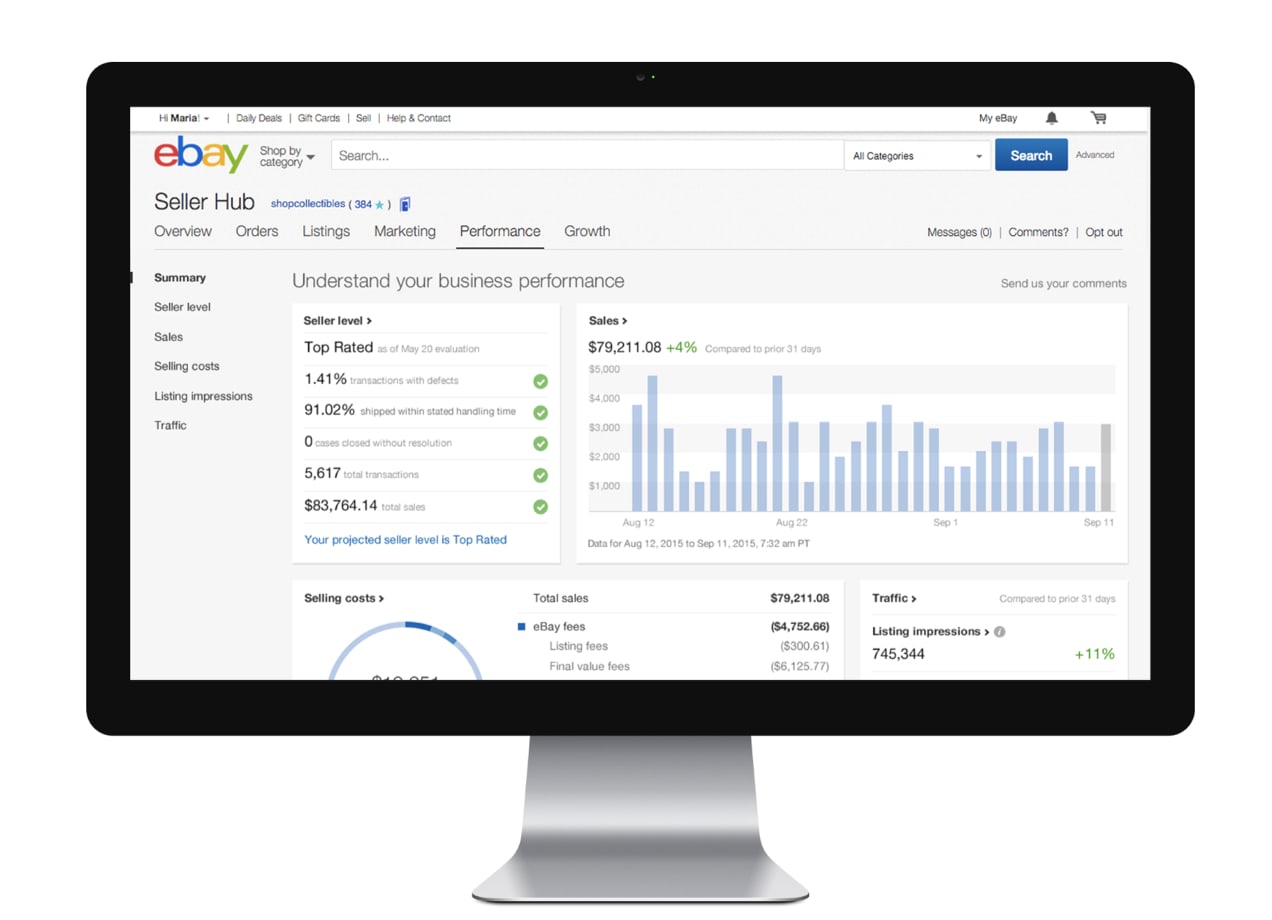
Shipping and delivery logistics
↑ Back to topShipping is a big part of ecommerce and when you sell on eBay, there are a few ways to make things easier and less costly.
First, you can use eBay delivery labels to save on costs.
You can print eBay shipping labels straight from your Seller Hub, affix them a box, and send out the item. If you don’t want to print labels, they also send you a QR code. You can take that to your local carrier store — UPS, FedEx, or the USPS — and scan the code there. They will then print the shipping label for you.
eBay also has a local pickup option if you want to ship locally.
There’s also eBay International Shipping, which makes shipping to other countries much easier, because eBay handles all the logistics, including refunds and returns. All you have to do is ship the item to an eBay domestic shipping hub, and they take it from there.
Here’s more information about eBay’s shipping services.
If you’re not sure about packaging, eBay sells a great variety of packaging materials, including boxes and envelopes of many sizes, and other shipping-related items.
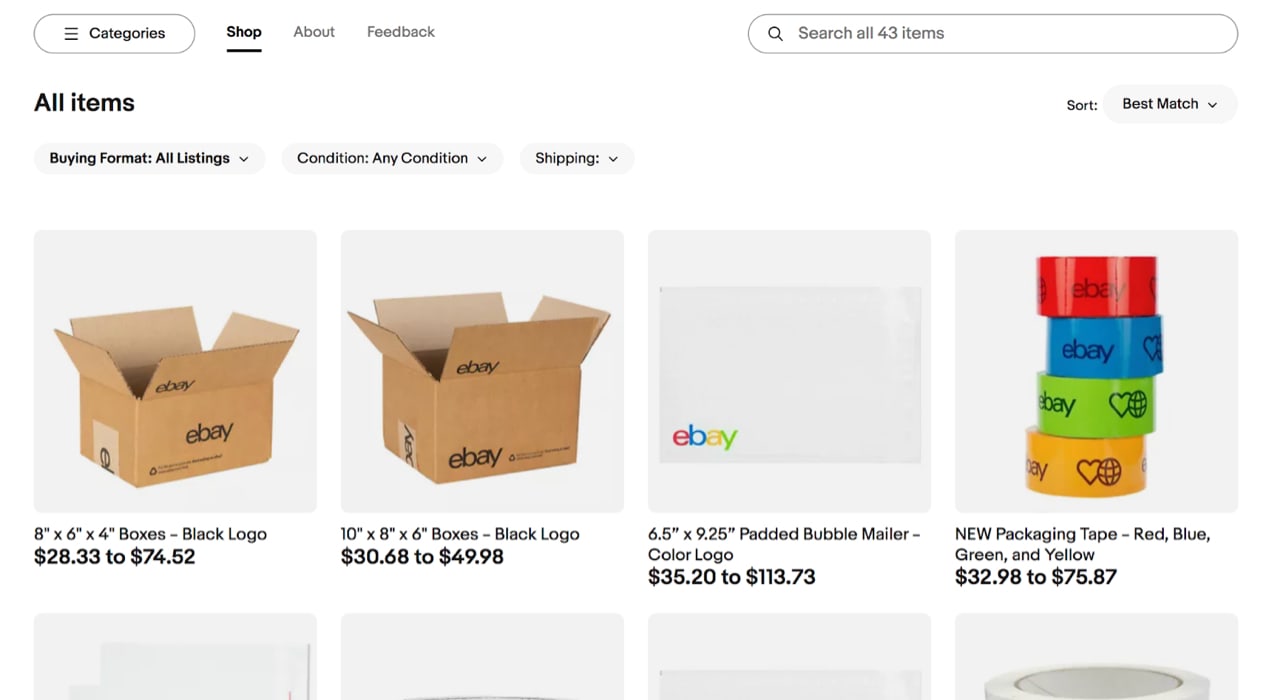
And eBay offers Seller Protection to prevent your seller ratings from harm due to situations outside of your control, such as weather or other delivery issues. With tracking, they’ll know if you shipped your product on time, so if something else prevents it from getting delivered on time, you won’t be penalized. They also protect you against abusive buyers.
Providing excellent customer service on eBay
↑ Back to topAs with any ecommerce store, the key to happy customers is to deliver great service. Daniel Sodkiewicz, CTO at GeekSeller agrees: “Providing good customer service can lead to positive feedback, which can boost sales, and learning from past sales and making improvements is key to doing better over time.”
Do what you say you will do. Communicate clearly and quickly. Send order confirmations. Send follow-up communications. Be available for questions by including your contact information in your eBay store, and respond when people reach out to you.
Make sure your packaging is the right size for your products, and that items are secured so they don’t get smashed around during shipping.
And to really wow your customers, include something fun or surprising in your packaging, like a special coupon, a free gift, a thank you card, a rewards club program, or anything else that will be noticed, appreciated, and delightful.
eBay and WooCommerce: A winning combination
↑ Back to topWhen you sell on eBay, there are many benefits — a built-in audience, pre-defined seller profiles, and logistical support — but your long-term security as an ecommerce business owner shouldn’t be left entirely in the hands of a third party.
Instead, it’s important to build assets that you fully control and can use for long-term equity development. This is what WooCommerce provides — the opportunity for you to build an online store that you own completely and that can’t be taken down for some arbitrary policy violation or bureaucratic mistake. This is one of many reasons WooCommerce is the best alternative to BigCommerce and Shopify.
You can develop a brand and own all of the creative work and intellectual property yourself. You can create a completely custom site with as many — or as few — bells and whistles as you’d like. At the end of the day, there’s only so much you can do on third-party platforms like eBay to stand out from the shop next door.
But you don’t have to choose between eBay and building your own store on WooCommerce.
You can do both.
The best of both worlds: WooCommerce and eBay
With the help of the eBay Integration for WooCommerce extension, you can seamlessly connect your stores on both platforms. Sync product information, like descriptions and inventory levels, across accounts. Plus, manage all of your orders for both WooCommerce and eBay directly in your WordPress dashboard.
Ready to sell online and reach your audience while maintaining full flexibility and control? Get started with WooCommerce.
About





